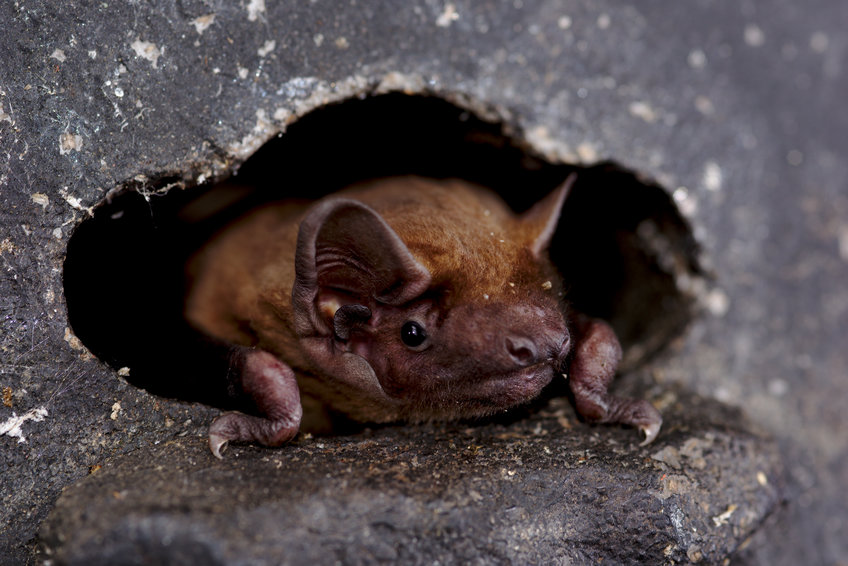Every bat travels differently
Noctule bats follow individual routes to their nursery roosts
The females of some bat species migrate hundreds of kilometres after hibernation to give birth to their offspring in insect-rich regions. Unlike birds, it is largely unknown how bats keep their energy consumption low during flight. Dina Dechmann and colleagues from the Max Planck Institute of Animal Behavior in Konstanz equipped female common noctule bats with air pressure sensors and tracked their flights. This enabled the researchers to record the flight direction and altitude. The data show that, whilst the Nyctalus bats all fly in a similar direction, they each choose their own specific flight altitude, distances and resting places. This suggests that each bat takes advantage of the prevailing weather and terrain to optimize its own individual flight.

Approximately 4000 different vertebrate species are categorized as "true migrators" – i.e. animals that regularly travel longer distances – in the Global Register of Migratory Species. Whilst bird migration is relatively well studied, there are considerable gaps in our knowledge of other species such as bats.
Of the 45 species of bat found in Europe, only four fly further than 1000 kilometres. This includes the common noctule (Nyctalus noctula), which is native to southern Germany among other regions. Following hibernation, the females of this species migrate to more insect-rich areas in the northeast where they give birth to their offspring and rear them to independence, before returning to mate and hibernate in the autumn. In earlier studies, Dina Dechmann and her colleagues had already discovered that the bats’ decision to begin their migration depends on the interaction between wind speed, wind direction and air pressure. However, the researchers still knew very little about the exact flight paths taken by individual animals.
Sensors measure air pressure
However, it is not so easy to follow the common noctule on its migration to the summer regions. GPS transmitters, which could be used to track the animals, would need a lot of energy for the entire migration period. Since this cannot be obtained from solar cells in nocturnal animals, additional batteries would have to be attached to the animals' backs, but these would be far too heavy for the common noctule, which weighs in at just 30 grams. "We therefore developed another way of tracking the animals as they migrate", says Dechmann. The researchers equipped the bats with small air pressure sensors with in-built transmitters that emit a modified radio signal on the basis of which the researchers can determine the flight altitude and wing beat frequency of the animals.
During the migration period, the researchers recorded the signals emitted by the transmitters on the bats in the evenings. As soon as one of them started to fly in a steady straight direction, the scientists switched to tracking the transmitter's signal by plane, which enabled them to follow the routes of five common noctules and record the altitude profiles of three of them. The researchers observed that the common noctules flew in a similar direction, but at different altitudes and over different distances: even individuals who had been fitted with transmitters in the same daytime roosts travelled separately and chose different resting places.
Flying at varying altitudes
Surprisingly, the bats also used different strategies, regarding flight altitude. One of the animals observed even turned back during its flight, and set off again the following night using different altitudes over a different track. The common noctules seem to decide individually how to optimize their flights according to the prevailing wind conditions and terrain. "One and the same animal can behave differently from one night to the next", says Dechmann. Although surprising this variability in migration behaviour is matched by those of the single bird species, a North American thrush, for which similarly detailed tracks are available. Many birds choose a flight altitude and maintain it, but there are exceptions. Whether the noctule is also such an exception only future work will show.
The researchers can use the altitude data to determine the extent to which the animals orient with regard to the features of the terrain and whether they can, for example, exploit updrafts. "We need more data to answer this question", Dechmann explains.
Each night during their migratory flights, common noctules eat a variety of insects, such as beetles and moths, including pest species. They, therefore, play an important role in the natural economy. However, many of the bats are killed en route as a result of collisions with wind turbines. "If we had a better understanding of their flightpaths and flight altitude”, says Dechmann, “we would be in a better position to identify any threats to the animals and implement countermeasures".
KN/HR












